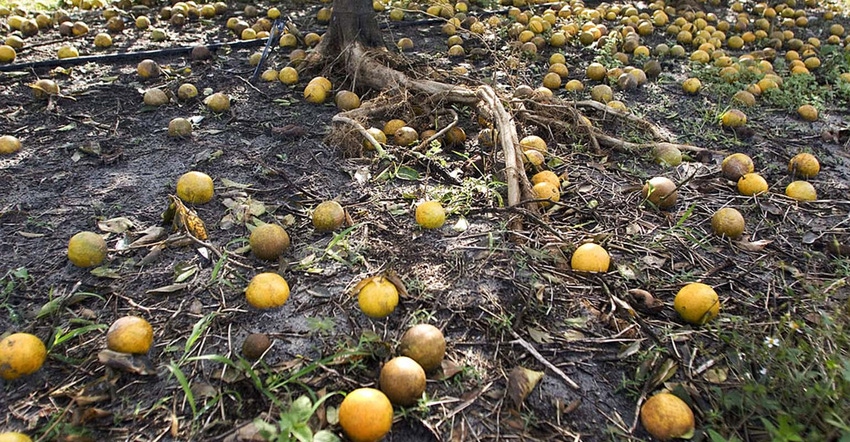
by Alan Bjerga
In the U.S, government-backed insurance plans help compensate farmers for losses after natural disasters. Unfortunately for the produce growers that were ravaged by recent hurricanes, a lot of the nation’s vegetable and fruit crops aren’t covered.
Hurricanes Irma and Harvey, which devastated parts of Florida, Texas and the Gulf Coast, also hit some of the nation’s least-insured crops, based on data the U.S. Department of Agriculture is releasing in a report Wednesday. Nationwide, only 16% of peppers and 2% of strawberries, both key Florida products, are covered by insurance.
Federally backed crop insurance, which paid out a record $17.5 billion after a drought hit the Midwest in 2012, has become the main government protection for farmers against weather damage.
While plantings of crops like cotton are 100% covered by the government program, produce has lagged behind, with only 34% of vegetable acreage covered and many less-common products not covered by the program at all. In some instances, farmers have chosen not to get insurance. In others, the offerings are limited: Strawberries, for example, are only covered through a small pilot program.
‘Rare Events’
"Rare events can make it more challenging to develop policies, but we have very long records of hurricane strikes in the U.S.," said Tom Worth, the chief actuary for the USDA’s crop-insurance program. "One year is not the driver, but we’re learning more about the risks."
Low insurance coverage in some crops shows the need for better weather and crop-history data the government can then use to develop risk-protection tools, said Leiann Nelson, the senior underwriter for the USDA’s Risk Management Agency. She’s also the author of the insurance-coverage report, the first of its kind released since 2013.
"It all comes down to data," Nelson said in a phone interview from her office in Kansas City, Missouri. "We have to have the information for what risks crops face to create a product that’s actuarially sound."
Agricultural damage from Harvey, which reached Texas in August, and Irma, which touched Florida earlier this month, hasn’t been fully tallied. Agriculture Secretary Sonny Perdue pegged Harvey losses near $1 billion on Sept. 11. Still, it’s too early to predict crop-insurance payouts for the disasters, according to Heather Manzano, the acting administrator for the USDA’s Risk Management Agency.
More Responsive
In general, the insurance program is becoming more responsive to farm disasters as it has expanded, Nelson said. The number of crop types covered has risen to 551 this year from 325 in 2000.
While most produce coverage lags behind grains, oranges are an anomaly -- good news for Florida farmers, who are the world’s second-biggest growers. There’s insurance covering 86% of the fruit’s U.S. acres.
Farmers who don’t use crop insurance can manage risk through other means, said Daniel Sumner, an agricultural economist at the University of California-Davis.
"Diversification in crops, diversification in market channels, saving and investments across alternative instruments, lines of credit, vertical integration and using tools like forward contracting" can hedge risk, Sumner said in an email. Growers of short-season fresh produce can sometimes simply replant, as they have several harvests per year, he said.
Not every crop has the data or support from growers to justify developing insurance, Nelson said. The USDA report includes a section on the feasibility of policies for different crops. Broccoli and artichoke growers rejected the idea, while mango and guava support was insufficient, even though the USDA felt it could design insurance for such crops.
More highlights from the USDA report:
About 86% of U.S. crop acreage was covered by insurance in 2015, up from 73% in 2000 and 36% in 1990.
Tobacco, peanuts, corn and soybeans are insured on at least 89% of all acres, and 85% of wheat is covered.
About 46% of payouts last year were because of heavy rains and floods, while 23% relieved drought and 11% covered hail.
Federally backed crop insurance had a 20-year average annual loss ratio of 0.85%, within guidelines. The rate of improper payments declined to 2.02% in 2016. For comparison, the Supplemental Nutrition Assistance Program, the biggest USDA program, had an error rate of 3.66% in 2014, the last year for which data is available.
To contact the reporter on this story: Alan Bjerga in Washington at [email protected]
To contact the editors responsible for this story: Simon Casey at [email protected]
Millie Munshi, Margot Habiby
© 2017 Bloomberg L.P
About the Author(s)
You May Also Like




